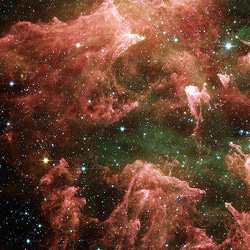
Spitzer view of the Carina Nebula, a well known nebula containing newborn stars in the Milky Way. Image credit: Spitzer. Click to enlarge.
The saga of how a few monstrous stars spawned a diverse community of additional stars is told in a new image from NASA’s Spitzer Space Telescope.
The striking picture reveals an eclectic mix of embryonic stars living in the tattered neighborhood of one of the most famous massive stars in our Milky Way galaxy, Eta Carinae. Astronomers say that radiation and winds from Eta Carinae and its massive siblings ripped apart the surrounding cloud of gas and dust, shocking the new stars into being.
“We knew that stars were forming in this region before, but Spitzer has shown us that the whole environment is swarming with embryonic stars of an unprecedented multitude of different masses and ages,” said Dr. Robert Gehrz, University of Minnesota, Twin Cities, a member of the team that made the Spitzer observations.
The results were presented yesterday at the 206th meeting of the American Astronomical Society in Minneapolis by Dr. Nathan Smith, lead investigator of the Spitzer findings, University of Colorado, Boulder.
Previous visible-light images of this region, called the Carina Nebula, show cloudy finger-like pillars of dust, all pointing toward Eta Carinae at the center. Spitzer’s infrared eyes cut through much of this dust to expose incubating stars embedded inside the pillars, as well as new star-studded pillars never before seen.
Eta Carinae, located 10,000 light-years from Earth, was once the second brightest star in the sky. It is so massive, more than 100 times the mass of our Sun, it can barely hold itself together. Over the years, it has brightened and faded as material has shot away from its surface. Some astronomers think Eta Carinae might die in a supernova blast within our lifetime.
Eta Carinae’s home, the Carina Nebula, is also quite big, stretching across 200 light-years of space. This colossal cloud of gas and dust not only gave birth to Eta Carinae, but also to a handful of slightly less massive sibling stars. When massive stars like these are born, they rapidly begin to shred to pieces the very cloud that nurtured them, forcing gas and dust to clump together and collapse into new stars. The process continues to spread outward, triggering successive generations of fewer and fewer stars. Our own Sun may have grown up in a similar environment.
The new Spitzer image offers astronomers a detailed “family tree” of the Carina Nebula. At the top of the hierarchy are the grandparents, Eta Carinae and its siblings, and below them are the generations of progeny of different sizes and ages.
“Now we have a controlled experiment for understanding how one giant gas and dust cloud can produce such a wide variety of stars,” said Gehrz.
The false colors in the Spitzer picture correspond to different infrared wavelengths. Red represents dust features and green shows hot gas. Embryonic stars are yellow or white and foreground stars are blue. Eta Carinae itself lies just off the top of image. It is too bright for infrared telescopes to observe.
JPL manages the Spitzer Space Telescope mission for NASA’s Science Mission Directorate, Washington. Science operations are conducted at the Spitzer Science Center at the California Institute of Technology in Pasadena. JPL is a division of Caltech. Spitzer’s infrared array camera, which took the picture of the Carina Nebula, was built by NASA Goddard Space Flight Center, Greenbelt, Md.; its development was led by Dr. Giovanni Fazio, Smithsonian Astrophysical Observatory, Cambridge, Mass.
Additional information about the Spitzer Space Telescope is available at: http://www.spitzer.caltech.edu/spitzer.
Original Source: Spitzer News Release
